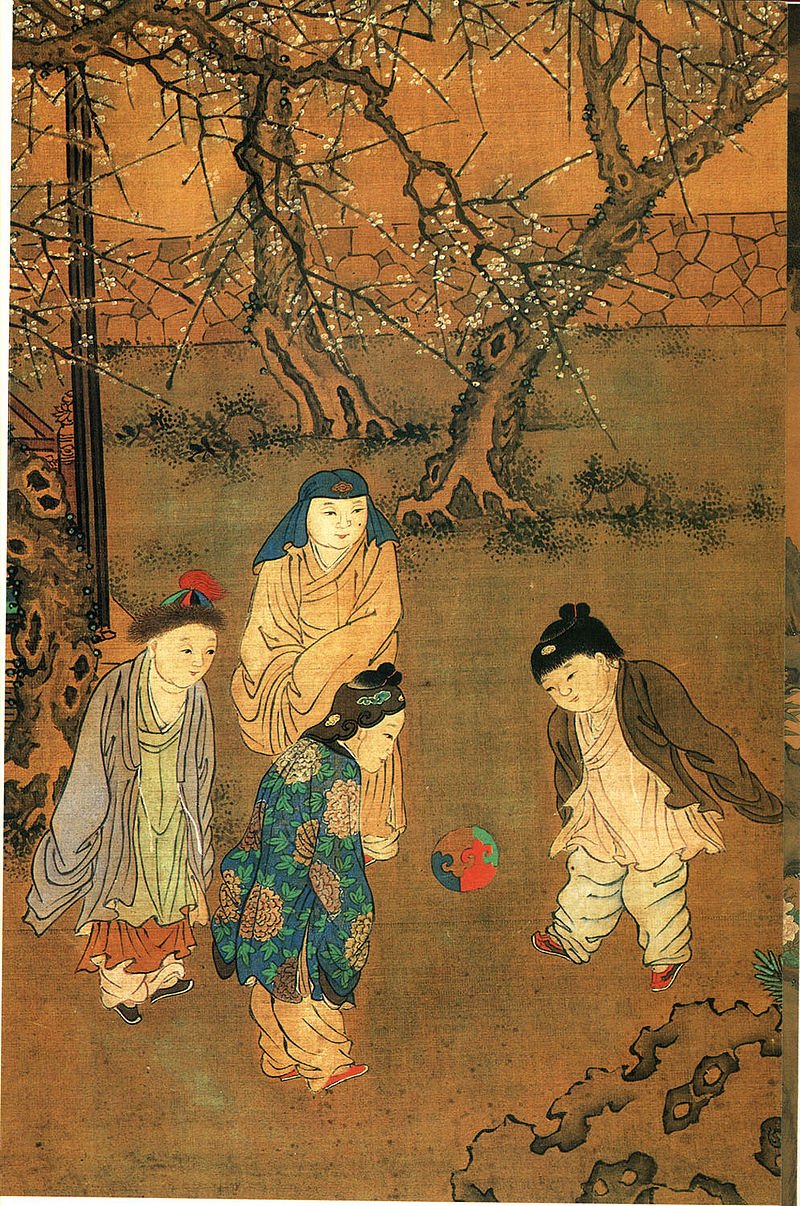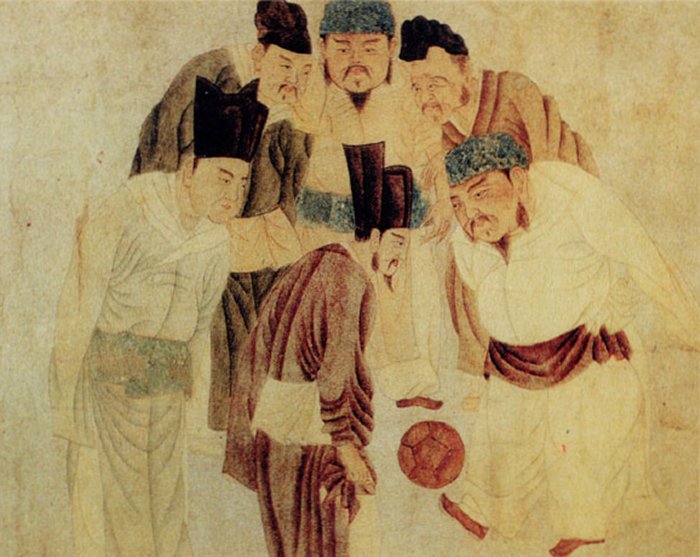Ancient Chinese Ball Game Cuju Is Earliest Form Of Football
Conny Waters - AncientPages.com - An interesting question is when and where we started playing football.
There are several references to traditional, ancient, or prehistoric ball games played by indigenous peoples in many parts of the world. The history of football stretches far back in time. According to FIFA, the competitive game cuju is the earliest form of football for which there is scientific evidence.
One Hundred Children in the Long Spring, a painting by Chinese artist Su Hanchen, active AD 1130–the 1160s), Song Dynasty. Image credit: Su Hanchen - source - Public Domain
Cuju is an ancient Chinese ball game, Cantonese "chuk-ko". It is a competitive game that involves kicking a ball through an opening into a net. The first mention of cuju in a historical text is in the Warring States era Zhan Guo Ce, in the section describing the state of Qi.
It is also described in Sima Qian's Records of the Grand Historian (under Su Qin's biography), written during the Han Dynasty. A competitive form of cuju was used as fitness training for military cavaliers, while other forms were played for entertainment in wealthy cities like Linzi.
During the Han Dynasty (206 BC-AD 220), the popularity of cuju spread from the army to the royal courts and upper classes. It is said that the Han emperor Wu Di enjoyed the sport. At the same time, cuju games were standardized, and rules were established. Cuju matches were often held inside the imperial palace.
Emperor Taizu of Song playing cuju with Prime Minister Zhao Pu, by the Yuan-era painter Qian Xuan (1235–1305). Image credit: Qian Xuan - source - Public Domain
Later, the sport was improved during the Tang Dynasty (618-907). First of all, the feather-stuffed ball was replaced by an air-filled ball with a two-layered hull. The capital of Chang'an during this dynasty was filled with several cuju football fields, which were even established on the grounds of the palaces.
Soldiers in the imperial army and Gold Bird Guard often formed cuju football teams to delight the emperor and his court.
Also, two types of goalposts emerged: One was made by setting up posts with a net between them, and the other consisted of just one goalpost in the middle of the field. The level of female cuju teams also improved. Records indicate that once, a 17-year-old girl beat a group of army soldiers. Cuju football even became popular amongst scholars and intellectuals, and if a courtier lacked skill in the game, he could pardon himself by acting as a scorekeeper.
During the Song Dynasty (960-1279), Cuju flourished thanks to social and economic development, and its popularity reached every class. Cuju organizations were set up in large cities called Qi Yun She or Yuan She - now known as the earliest professional cuju club - whose members were either cuju lovers or professional performers. There was only one goalpost set up in the center of the field.
Non-professional players had to formally appoint a professional teacher and pay a fee before becoming a member.
Cuju began its decline during the Ming Dynasty (1368-1644) due to neglect, and the 2,000-year-old sport slowly faded away. Now it is coming back again, gaining more and more popularity.
Modern football has its origin in the streets of medieval England. Neighboring towns would play each other in games where a heaving mass of players would struggle to drag a pig's bladder by any means possible to markers at either end of town. Football became so violent in England that the king banned it for over 300 years.
Updated on March 3, 2023
Written by Conny Waters – AncientPages.com Staff Writer
Copyright © AncientPages.com All rights reserved. This material may not be published, broadcast, rewritten or redistributed in whole or part without the express written permission of AncientPages.com
Expand for referencesReferences:
Image: A Song Dynasty painting by Su Hanchen, depicting Chinese children playing cuju - Credit: Su Hanchen
More From Ancient Pages
-
 Re-Evaluation Of Liujiang Skeleton’s Dating Sheds New Light On Human Occupation In China
Fossils | May 27, 2024
Re-Evaluation Of Liujiang Skeleton’s Dating Sheds New Light On Human Occupation In China
Fossils | May 27, 2024 -
 Reconstrucion Of The 19-Meter-Long Gjellestad Viking Ship In Progress
News | Oct 9, 2023
Reconstrucion Of The 19-Meter-Long Gjellestad Viking Ship In Progress
News | Oct 9, 2023 -
 Pyramid Of The Moon At Teotihuacán – Underground Tunnel And Chamber Found
Archaeology | Oct 29, 2018
Pyramid Of The Moon At Teotihuacán – Underground Tunnel And Chamber Found
Archaeology | Oct 29, 2018 -
 Ptolemaic-Era Warship Discovered Near The Sunken City Of Heracleion In Alexandria By Underwater Archaeologists
Archaeology | Jul 20, 2022
Ptolemaic-Era Warship Discovered Near The Sunken City Of Heracleion In Alexandria By Underwater Archaeologists
Archaeology | Jul 20, 2022 -
 Why Has Only One Such Puzzling Ancient Object Been Found In Norway?
Artifacts | May 4, 2018
Why Has Only One Such Puzzling Ancient Object Been Found In Norway?
Artifacts | May 4, 2018 -
 Mysterious Old Ship With No Crew Reaches The Canadian Coast
Featured Stories | Jul 25, 2024
Mysterious Old Ship With No Crew Reaches The Canadian Coast
Featured Stories | Jul 25, 2024 -
 Ancient Mystery Of Egypt’s Black Pyramid – Did It Really Exist?
Featured Stories | Nov 28, 2020
Ancient Mystery Of Egypt’s Black Pyramid – Did It Really Exist?
Featured Stories | Nov 28, 2020 -
 Brokkr And Eitri – Norse Dwarves Who Fashioned Magical Artifacts For The Gods
Featured Stories | Aug 19, 2019
Brokkr And Eitri – Norse Dwarves Who Fashioned Magical Artifacts For The Gods
Featured Stories | Aug 19, 2019 -
 On This Day In History: Krakatoa – Most Dangerous Volcano Erupted- On August 26, 1883
News | Aug 26, 2016
On This Day In History: Krakatoa – Most Dangerous Volcano Erupted- On August 26, 1883
News | Aug 26, 2016 -
 Amazing Thirteen Ming Tombs: Gigantic Stone Animals And Human Figures Were Symbols Of Royal Power
Civilizations | Oct 1, 2018
Amazing Thirteen Ming Tombs: Gigantic Stone Animals And Human Figures Were Symbols Of Royal Power
Civilizations | Oct 1, 2018 -
 Rare Ancient Clothes And Shoes Found Under The Ice At The Lost Lendbreen Mountain Pass
Featured Stories | Feb 9, 2023
Rare Ancient Clothes And Shoes Found Under The Ice At The Lost Lendbreen Mountain Pass
Featured Stories | Feb 9, 2023 -
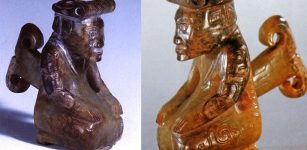 Peculiar Artifact Discovered In Tomb Of The Warrior Queen Fu Hao
Artifacts | Oct 26, 2018
Peculiar Artifact Discovered In Tomb Of The Warrior Queen Fu Hao
Artifacts | Oct 26, 2018 -
 Amazing Tomb Of Yuya And Tjuyu Filled With Ancient Treasures In The Valley Of The Kings
Featured Stories | Jun 2, 2021
Amazing Tomb Of Yuya And Tjuyu Filled With Ancient Treasures In The Valley Of The Kings
Featured Stories | Jun 2, 2021 -
 Remains of Maurya-Era Wall Discovered In Tilaurakot, Kapilvastu, Nepal
Archaeology | Jun 16, 2022
Remains of Maurya-Era Wall Discovered In Tilaurakot, Kapilvastu, Nepal
Archaeology | Jun 16, 2022 -
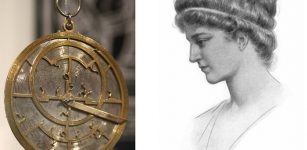 Hypatia Of Alexandria – Brilliant, Controversial Scientist And Her Dramatic End
Featured Stories | Jan 7, 2019
Hypatia Of Alexandria – Brilliant, Controversial Scientist And Her Dramatic End
Featured Stories | Jan 7, 2019 -
 Mysterious Black Cloud Caused A Global Catastrophe In 536 A.D. And 18 Months Of Darkness
Featured Stories | May 25, 2021
Mysterious Black Cloud Caused A Global Catastrophe In 536 A.D. And 18 Months Of Darkness
Featured Stories | May 25, 2021 -
 On This Day In History: Treaty of York Was Signed – On Sep 25, 1237
News | Sep 25, 2016
On This Day In History: Treaty of York Was Signed – On Sep 25, 1237
News | Sep 25, 2016 -
 Exploring Ancient Secrets Of An Ancestral Maya Neighborhood And Some Puzzling Buildings
Archaeology | Sep 10, 2022
Exploring Ancient Secrets Of An Ancestral Maya Neighborhood And Some Puzzling Buildings
Archaeology | Sep 10, 2022 -
 Lost Viking Village Borgund And Its 45,000 Artifacts Hidden In A Basement Examined By Experts
Archaeology | Apr 22, 2022
Lost Viking Village Borgund And Its 45,000 Artifacts Hidden In A Basement Examined By Experts
Archaeology | Apr 22, 2022 -
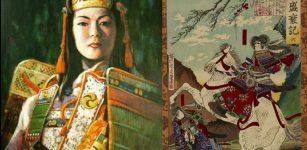 Tomoe Gozen’s Bravery And Strength, Embodiment Of A True Female Samurai
Featured Stories | Oct 16, 2018
Tomoe Gozen’s Bravery And Strength, Embodiment Of A True Female Samurai
Featured Stories | Oct 16, 2018

